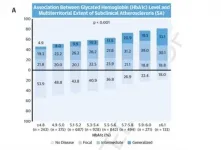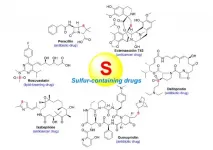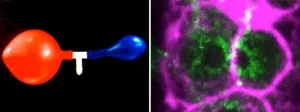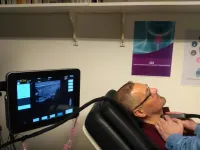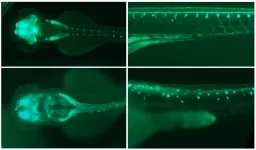INFORMATION:
The study was funded by the Instituto de Salud Carlos III (ISCIII, PI15/ 02019, PI17/00590, PI20/00819) and the European Regional Development Fund (ERDF) "A way to make Europe" and included scientists from the CIBER de Enfermedades CardioVasculares (CiberCV) research network.
A blood sugar biomarker identifies patients with atherosclerosis and a risk of cardiovascular events
Glycosylated hemoglobin is measured with a cheap diagnostic test that is accessible and widely used in daily clinical practice
2021-06-01
(Press-News.org) The routine use of the glycosylated hemoglobin test to track blood sugar levels in the general population can identify individuals with more advanced atherosclerotic disease. Currently used in the diagnosis and management of diabetes, glycosylated hemoglobin can provide a useful estimate of atherosclerotic disease, and therefore of cardiovascular risk, in individuals without diabetes with or without possible prediabetes. This is the main finding of a study carried out by scientists at the Centro Nacional de Investigaciones Cardiovasculares (CNIC).
The advance heralded by the CNIC study is the use of this blood-sugar measure in apparently healthy middle-aged individuals who do not have diabetes mellitus but with or without possible prediabetes. When used in combination with traditional risk factors (hypertension, dyslipidemia, and smoking), the glycosylated hemoglobin test more accurately distinguishes between people at high and low risk of atherosclerotic disease.
The study, published today in The Journal of American College of Cardiology (JACC), proposes that, because glycosylated hemoglobin levels can easily be reduced through lifestyle changes, the test should be at the front line of risk reduction strategies.
The glycosylated hemoglobin diagnostic test is cheap, accessible, and widely used in daily clinical practice, explained Dr. Xavier Rosselló, CNIC scientist and cardiologist at Hospital Universitario Son Espases in Palma de Mallorca. The test can therefore be put to immediate use to calculate the degree of subclinical atherosclerosis in the general population.
According to CNIC General Director Dr. Valentín Fuster, this new information "will help to provide a more personalized assessment of cardiovascular risk at almost no additional cost, paving the way to personalized treatment plans principally focused on lifestyle changes, followed when necessary by treatment with antidiabetic drugs."
The study forms part of the collaborative PESA-CNIC-SANTANDER project, which is led by Dr. Fuster. Begun in 2010 and recently extended until 2030, the PESA-CNIC-SANTANDER study is one of the most important cardiovascular prevention studies in the world.
Atherosclerosis is usually only detected at advanced stages, after it has already triggered a cardiovascular event such as a myocardial infarction or stroke. Events of this type severely worsen patient prognosis, and the early detection of atherosclerosis--the underlying cause--is therefore vital for extending lifespan and quality of life.
The new CNIC finding provides a simple way to increase the accuracy of cardiovascular risk ranking in individuals without diabetes with or without prediabetes.
According to Dr. Rosselló, "the glycosylated hemoglobin test was especially useful in identifying subclinical disease in participants classified at low risk according to traditional scores; it made less of a contribution to risk calculation for individuals who already had a moderate level risk according to other risk factors."
The authors conclude that "this study establishes glycosylated hemoglobin as a mass-use biomarker because its greatest benefit is in individuals at low cardiovascular risk, who form the immense majority of the general population and account for most cardiovascular deaths in absolute terms."
The study was conducted by a multidisciplinary team that included physicians, biologists, statisticians, bioinformaticians, nurses, and many other professionals who, with together with the Banco Santander employees who make up the study population, make the PESA study possible.
ELSE PRESS RELEASES FROM THIS DATE:
Zhores supercomputer helps Skoltech researchers model new method of generating gamma-ray combs
2021-06-01
Skoltech researchers used the resources of the university's Zhores supercomputer to study a new method of generating gamma-ray combs for nuclear and X-ray photonics and spectroscopy of new materials. The paper was published in the journal Physical Review Letters.
A gamma-ray comb is a series of short bursts that, when plotted as intensity versus frequency, look like sharp and equally spaced teeth of a comb. Generating these combs at high brightness in the gamma-ray domain has been challenging because of something called ponderomotive spectral broadening - an effect that destroys the monochromaticity that allows gamma-ray sources to be used in nuclear spectroscopy, medicine, and other applications.
Sergey ...
Chemistry and biology of sulfur containing natural products from marine microorganisms
2021-06-01
The intriguing chemistry and biology of sulfur?containing natural products from marine microorganisms (1987-2020)
https://doi.org/10.1007/s42995-021-00101-2
Announcing a new publication for Marine Life Science & Technology journal. In this review article the authors Yang Hai, Mei?Yan Wei, Chang?Yun Wang, Yu?Cheng Gu and Chang?Lun Shao from Ocean University of China, Qingdao, China and Syngenta Jealott's Hill International Research Centre, Berkshire, UK consider the chemistry and biology of sulfur?containing natural products from marine microorganisms.
Natural products derived ...
Academic journal Polar Science features science in the Arctic
2021-06-01
The National Institute of Polar Research (NIPR) publishes Polar Science, a peer-reviewed quarterly journal dealing with polar science in collaboration with the Elsevier B. V.. The most recent issue (Vol. 27 published in March 2021) was a special issue entitled "Arctic Challenge for Sustainability Project (ArCS)," which featured the former national (nation-wide) Arctic research project in Japan. The full text of this issue is freely accessible worldwide for a limited time until 10 September 2021.
The Arctic Research Project "Arctic Challenge for Sustainability (ArCS)" was carried out from September 2015 to March 2020 as a national flagship project funded by the Ministry of Education, Culture, Sports, ...
Hydraulic instability decides who's to die and who's to live
2021-06-01
In past studies, researchers have found that C. elegans gonads generate more germ cells than needed and that only half of them grow to become oocytes, while the rest shrinks and die by physiological apoptosis, a programmed cell death that occurs in multicellular organisms. Now, scientists from the Biotechnology Center of the TU Dresden (BIOTEC), the Max Planck Institute of Molecular Cell Biology and Genetics (MPI-CBG), the Cluster of Excellence Physics of Life (PoL) at the TU Dresden, the Max Planck Institute for the Physics of Complex Systems (MPI-PKS), the Flatiron Institute, NY, and the University of California, Berkeley, found evidence to answer the question of what triggers this cell fate decision between life and death in the germline.
Prior studies ...
Larger sample sizes needed to avoid false negative findings in vitamin D trials
2021-06-01
Researchers from Trinity College Dublin have developed a novel set of tools for designing vitamin D clinical trials that capture large seasonal and population-wide differences in vitamin D status, typically seen in individuals. Their study published in the journal Scientific Reports (today, Monday 31st May 2021) provides a framework for clinical trials to establish whether vitamin D supplementation is effective against a given disease.
The study also reveals that many trials which failed to find any association between vitamin D and disease prevention may have been underpowered or conducted without enough subjects to detect a benefit of vitamin D.
You can read the full journal paper here: https://go.nature.com/3uERjgO
The ...
What could possibly go wrong with virtual reality?
2021-06-01
YouTube is a treasure trove of virtual reality fails: users tripping, colliding into walls and smacking inanimate and animate objects. By investigating these "VR Fails" on YouTube, researchers at the University of Copenhagen have sought to learn more about when and why things go sideways for users and how to improve VR design and experiences so as to avoid accidents.
Millions of YouTube viewers have enjoyed hearty laughs watching others getting hurt using virtual reality - people wearing VR headsets, falling, screaming, crashing into walls and TV sets, or knocking spectators to the floor. Some of us have even been that failing someone. Now, videos of virtual reality mishaps, called "VR Fails", ...
Hybrid redox-flow battery with a long cycle life
2021-06-01
Redox-flow batteries store electrical energy in chemical compounds that are dissolved in an electrolyte. They are a particularly promising alternative to lithium-ion batteries as stationary energy storage. A team headed by Prof. Dr. Ingo Krossing from the Institute of Inorganic and Analytical Chemistry at the University of Freiburg has succeeded in developing a non-aqueous All-Manganese Flow battery (All-MFB) that uses sustainable manganese as its active material and has a long cycle life. The researchers present the results of their work in the latest edition of Advanced Energy Materials.
Active materials are ...
Artificial intelligence enables smart control and fair sharing of resources in energy communities
2021-06-01
Energy communities will play a key role in building the more decentralised, less carbon intensive, and fairer energy systems of the future. Such communities enable local prosumers (consumers with own generation and storage) to generate, store and trade energy with each other -- using locally owned assets, such as wind turbines, rooftop solar panels and batteries. In turn, this enables the community to use more locally generated renewable generation, and shifts the market power from large utility companies to individual prosumers.
Energy community projects often involve jointly-owned assets such as community-owned wind turbines or shared battery storage. Yet, this raises the question of how these assets should be controlled - often in real time, and how the energy outputs jointly-owned ...
The LUCA device proves its readiness for a better thyroid cancer screening
2021-06-01
Thyroid nodules are a common pathology having a prevalence of 19-76% when screened with ultrasound, with higher frequencies in women. Current medical methods used to assess the malignancy of a nodule consist in performing an ultrasound, followed by a Doppler ultrasound, and then a biopsy. However, unfortunately, these methods present both low specificity and low sensitivity. This insufficient effectiveness in accurately being able to diagnose thyroid tumors leads to many unclear or unnoticed cases as well as many others that undergo unnecessary surgeries (false positives) and increase the cost ...
Gene plays major role in brain development
2021-06-01
When the Augustinian monk Gregor Mendel crossed white-flowering with purple-flowering pea plants in the mid-19th century, he made an interesting discovery: The offspring were all purple. He therefore called this trait dominant, while the white blossom color was recessive. The reason for this phenomenon: In peas, each gene occurs twice. One version comes from the maternal plant and the other from the paternal plant. If a pea has inherited the gene for purple flower color from one parent, but the gene for white flower color from the other, purple wins. Only when two genes for white flowers come together in the offspring plant is it white.
Humans also have genes that are inherited either dominantly or recessively. However, the case is not so clear for the mutations investigated ...
LAST 30 PRESS RELEASES:
Ticking time bomb: Some farmers report as many as 70 tick encounters over a 6-month period
Turning garden and crop waste into plastics
Scientists discover ‘platypus galaxies’ in the early universe
Seeing thyroid cancer in a new light: when AI meets label-free imaging in the operating room
Neutrophil-to-lymphocyte ratio may aid risk stratification in depressive disorder
2026 Seismological Society of America Annual Meeting
AI-powered ECG analysis offers promising path for early detection of chronic obstructive pulmonary disease, says Mount Sinai researchers
GIMM uncovers flaws in lab-grown heart cells and paves the way for improved treatments
Cracking the evolutionary code of sleep
Medications could help the aging brain cope with surgery, memory impairment
Back pain linked to worse sleep years later in men over 65, according to study
CDC urges ‘shared decision-making’ on some childhood vaccines; many unclear about what that means
New research finds that an ‘equal treatment’ approach to economic opportunity advertising can backfire
Researchers create shape-shifting, self-navigating microparticles
Science army mobilizes to map US soil microbiome
Researchers develop new tools to turn grain crops into biosensors
Do supervised consumption sites bring increased crime? Study suggests that’s a myth
New mass spec innovation could transform research
Maternal nativity, race, and ethnicity and infant mortality in the US
Migration-related trauma among asylum seekers exposed to the migrant protection protocols
Jupiter’s moon Europa has a seafloor that may be quiet and lifeless
SwRI upgrades nuclear magnetic resonance laboratory for pharmaceutical R&D
House sparrows in northern Norway can help us save other endangered animals
Crohn's & Colitis Foundation survey reveals more than 1/3 of young adults with IBD face step therapy insurance barriers
Tethered UAV autonomous knotting on environmental structures for transport
Decentralized social media platforms unlock authentic consumer feedback
American Pediatric Society announces Vanderbilt University School of Medicine as host institution for APS Howland Visiting Professor Program
Scientists discover first method to safely back up quantum information
A role for orange pigments in birds and human redheads
Pathways to net-zero greenhouse gas emissions for Southeast Asia
[Press-News.org] A blood sugar biomarker identifies patients with atherosclerosis and a risk of cardiovascular eventsGlycosylated hemoglobin is measured with a cheap diagnostic test that is accessible and widely used in daily clinical practice
